Those of you old enough to remember the TV show The Honeymooners may also recall their ice box, which (spoiler alert!) is on this list.
But if storing your food next to a block of ice isn’t appealing, I’ve got six other refrigeration options for off-grid living. One of which is sure to be a perfect fit.
Refrigeration as a modern-day convenience
The first home refrigerator was invented in 1913, though another 10 years before Frigidaire created a self-contained unit. And it wasn’t until 1940 that the fridge/freezer combination we’re used to today was invented.
Factors to consider
The problem is that a typical American refrigerator isn’t going to work well off-grid. Which is exactly why I put together this roundup. And also why I’m starting with these essential factors to keep in mind.
- Where do you live?
- What resources do you have at your disposal?
- What’s your climate like?
- How much money do you want to invest in refrigeration and the power necessary to run it?
- What size do you need? Are you a single guy or The Waltons?
There is one other thing I’d like to point out first: Even though we Americans refrigerate nearly everything, this doesn’t mean everything needs to be refrigerated. See here for 100 foods that don’t require refrigeration.
Solving that riddle will no doubt reduce your refrigeration needs.
Also, we’ll list the easiest, cheapest, and least technologically-reliant first, moving toward more conventional and convenient options.
1. Zeer Pot
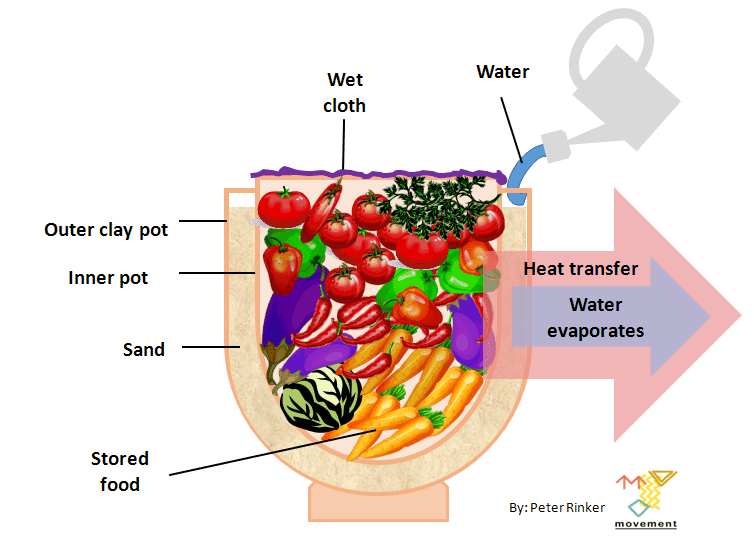
A zeer pot is an evaporative cooler invented in the 1990s in Nigeria by Mohammed Bah Abba. However, there is evidence of this style of refrigeration going back a couple of thousand years to ancient Egypt.
The mechanics of it are simple:
- Take two clay pots and nest them together.
- Fill the gap between them with wet sand.
- Place your produce in the smaller pot and cover it with a lid or towel.
- Place it in a shady area and ideally has a bit of a breeze.
As the water evaporates (by the wind, not the sun; this is important.), it chills the pot.
It essentially uses the water as a refrigerant. As the sand dries out, you’ll need to keep adding more water.
Don’t expect your zeer pot to get as cold as a refrigerator. However, if your climate is dry and the area is windy, temps can get as low as 40 degrees Fahrenheit.
Zeer pots don’t work as well in really humid areas. And they will go through water quickly in drier climates. Expect to add water to the sand about three times each day. Also, expect to use as much as two gallons of water per day.
Which leads us to …
You’ll have to decide which resource you have or want to conserve more. Those living in a desert may not find this water consumption worth it, while others with easy access to water may feel differently.
For those interested in putting together your own, here are some instructions for building the Cadillac of Zeer pots.
2. Ice Box/Cooler
The one advantage of coolers is they’re easy to use. There’s nothing to build; buy it, and you’re ready to go.
However, there are a few disadvantages.
Depending on your climate and the quality of the cooler you have, you may be getting ice frequently. And this source of ice will not be cheap, and it may not be close. ( Unless you have an ice house; more on this later.)
If you go with a high-quality cooler, like the Yeti brand (Amazon Link), your device will last longer, but you’ll also pay a few hundred dollars.
And then there’s the issue of soggy food. Because even with your best laid plans, intentions, and organization, water has a way of getting things wet. Wet hot dogs – not a big deal. Wet cheese – well, that’s just disgusting.
3. Ice House
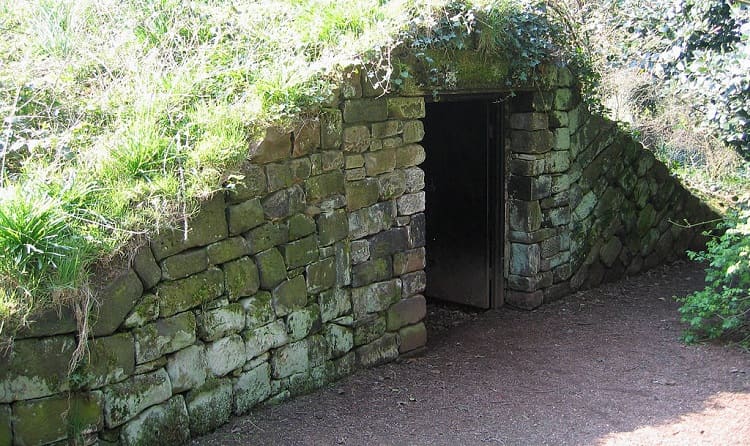
An ice house is simply a building used to store ice. It can be above ground, below ground, or partially below ground.
Keeping your ice below ground will keep it colder, like a root cellar, which will help you maintain your supply through the summer.
If you’re storing your ice above ground, you may want to insulate it. Sawdust and straw are both commonly used insulators.
You can nest two structures together like you nested two pots together for the zeer pot. Then, pack the space in between with your insulator of choice.
While storing the ice is straightforward, harvesting your ice isn’t. You’ll cut it from frozen lakes and rivers using a power saw or a machine specifically designed to harvest ice.
The video below shows more about how that’s done; it’s a fascinating process.
This refrigeration idea is obviously location-dependent; it’s also quite intensive and maybe even a bit risky. So factor that into your decision.
4. Root Cellar
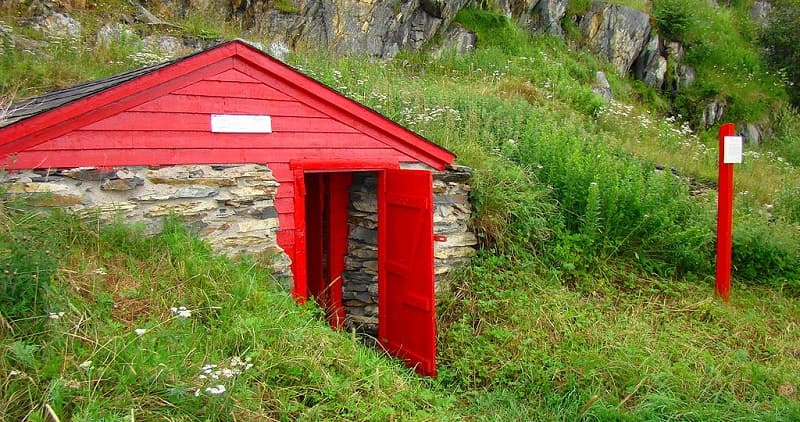
Root cellars are fantastic options even in conjunction with another primary source of refrigeration. There’s nothing like the security of having a backup supply of food on hand, just in case.
Historically, root cellars were used to keep root vegetables fresh through the winter. However, besides storing the summer’s harvest in whole-food form, you can also store canned and preserved food you prepared from that harvest.
Recommended Reading: Ultimate Guide To Food Preservation
The Farmer’s Almanac states that at 10 feet below ground, you’ll find what you most need in any root cellar – temperature stability.
This means you’ll be able to keep foods warmer in the winter and cooler in the summer.
Any structure that provides the natural insulation of the earth will work, such as
- Basements with a few modifications
- Structures built into the ground or side of a hill
- Barrel or garbage can
Remember our zeer pot. You can do the same thing with a garbage can. Dig the hole a little wider than the can and deep enough so that the lid is just a few inches above ground. Then, insulate the gap between the earth and the can with mulch or straw.
There are five things any root cellar needs to function correctly:
- Ventilation
- Shelter of the earth
- Darkness
- Humidity – between 85-95%
- Shelving – optional
Read this in-depth guide If you want to learn more about root cellars.
5. Propane Powered Refrigerators
Propane works great for heating, like water heaters, stoves, ovens, and home heaters. And they’re popular in RVs. However, people with RVs don’t generally use them in cold climates. The whole point is to move with the good weather.
You may be wondering, what does that have to do with anything?
Well, most propane refrigerators must be vented, which means busting through the exterior of your home and putting in vents. So when the weather turns nasty, as it tends to do in winter, you’ve got cold air venting into your house. But that’s not the worst part, as Ethan Waldman discovered.
Ethan, who lives in a cold climate, discovered that propane refrigerators don’t work very well when temperatures drop to the degree that they do way up north.
And without getting too technical (you can follow the link above for the technical), the absence of heat caused everything in his fridge to freeze.
The best that can be said for propane-powered refrigeration is that it’s a cheaper, out-of-box solution than a solar-powered fridge.
There’s not much in the way of initial set-up, except for those vents. And that lack of infrastructure may be appealing to some.
But even then, there are other issues, such as …
- More maintenance required
- More expensive than solar fridges
- More expensive to repair
- The hassle of getting refills
- Pilot lights go out
- Cleaning couplers and flues
- Propane could go way up in price
- You cannot produce it yourself
Moving off the grid is as much about independence as anything else for many folks.
Do you want to rely on a source of power you have no control over?
Yes, you can’t control the sun or the wind, but when the sun stops shining, we will never have to worry about anything again.
6. Solar Powered Refrigerators
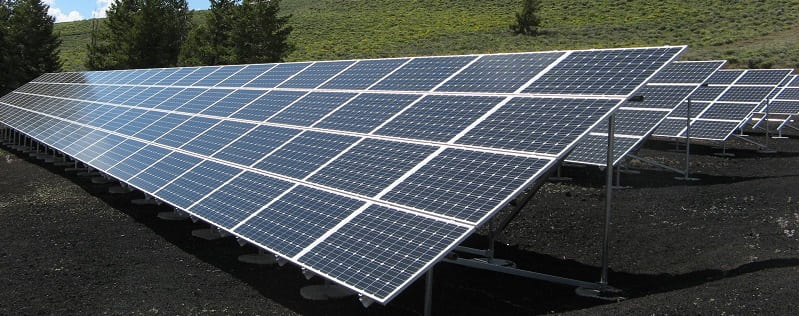
Any refrigerator will run on solar energy provided you have an inverter – which converts DC battery power to 120-volt AC power – and enough energy to get it running and keep it running. Or you could buy a solar-powered refrigerator.
A solar-powered fridge will cost you more upfront. But you’ll eliminate the need for an inverter — though you may need one for other off grid appliances anyway. And it’ll require much less energy, meaning fewer batteries and solar panels.
The other thing that contributes to energy efficiency is the style of the refrigerator.
The most efficient fridge/freezer combo is when the freezer is on top. Cold air is heavy, so with that style, the cold air naturally falls into the refrigerator chamber without fans or pumps.
When the freezer is on the bottom, pushing that cold air upward requires more energy. The other type, the side-by-side fridge/freezer, is also not as efficient.
A solar-powered refrigerator is a significant investment, to be sure. However, unlike regular refrigerators, they’ll require much less hardware. And when compared with propane refrigerators, they’re cheaper. Plus, you have the bonus of never worrying about the cost of propane going wild or even disappearing one day.
But if cost is an issue, and you still want something convenient and energy efficient, well, number seven on our list may be the perfect solution you’ve been looking for.
7. Chest Freezer Conversion
It seems that Tom Chalko, an Australian inventor, was the first to come up with this. Who can be sure?
His dream is to live a near-zero emission life, and this relatively simple and cheap conversion gets him pretty close. Have you ever heard of having your cake and eating it, too? This is it!
Once you have the few parts you need – an external thermostat, a temp sensor (thermistor), and a few smaller parts – it takes about a half hour to convert the chest freezer into a super-efficient refrigerator.
A chest freezer has better thermal insulation than refrigerators, allowing less energy consumption even at much lower temperatures.
And remember that fun fact from above about how cold air is heavy? In a chest freezer, when you open the door, that cold air doesn’t feel the need to escape.
Tom found that his new refrigerator, which operated in the 40 – 45 degrees range, used the same amount of energy in 24 hours as a 100-watt lightbulb uses in just one hour. How’s that for amazing?
If you are interested in doing a chest freezer conversion, check out the video below. It’s easy enough that anyone can do it. And so efficient that everyone should be doing it.
Conclusion
The one tip I repeatedly encountered during this article’s research was this: Use what nature already provides. Work with it, not against it, and you’ll be well on your way to off-grid living success.
So, while propane refrigerators may not make sense for those in the Upper Peninsula of Michigan, an ice house might. Those in the southwest who get upwards of 320 sunny days yearly will likely find solar energy a reliable resource.
And all of us, once we get 10 feet below ground, can use the earth’s consistent, year-round temps to store food.
Related
Read: How to preserve meat without refrigeration
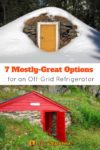
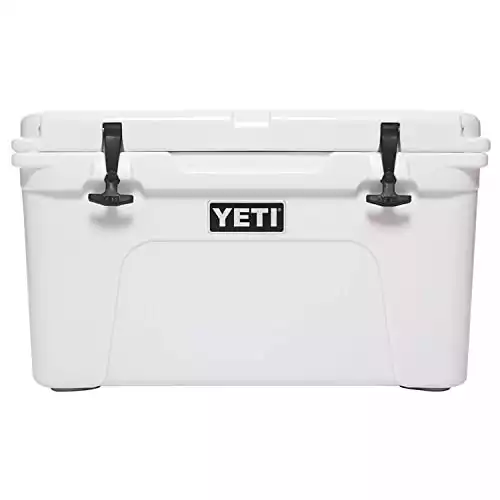
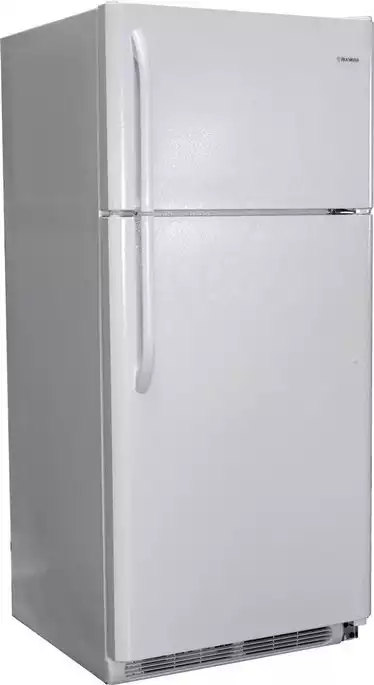


I’m a bit curious about the running of a freezer/fridge on a DC to AC inverter. My assumption was that this was pretty wasteful when on solar.
I personally run two Whynter 12V freezers/fridge on my solar/battery setup; one 95 quart as my freezer, and another 65 quart for my fridge.
I’ve used propane freezer/fridge combos in the past; great option if you don’t get a lot of sun, but they cost far roughly twice as much on top of being dependant on propane.
No idea how long these whynter products will last (1.5yrs so far), but I’ve had bad luck with propane fridge/freezer combos only lasting ~5yrs.
I run a chest freezer with an external thermostat / controller from ink bird. The controller costs about $40. You plug the freezer into the external controller. It turns on and off the freezer at user set temperatures. No modifications to the freezer needed other than fishing a wire past the door seal. Running amp draw on new compressors are around 1amp. Start up is a bit more but hard to find those specs and only momentary. My inverter will turn on its fan for start up and then off seconds later.
A note of caution about the chest freezer with external thermostat. It will work but after the sun goes down a smaller system will not be able to handle the surge of power required to start an induction motor compressor. This was with 4 L16 batteries.
Because of this I had significant food spoilage.
I’m told that a 3-way powered propane fridge can work on 120VDC as easily as 120 VAC. Simply hook up 3-4 solar panels directly. Not so good at night but that’s where the 12 VDC option comes in. Prepping is all about options on options on options.
If you go back in time pre 1900’s you will find references to cooling houses or spring houses. They use water diverted from a moving water source (stream, spring) into a trough typically made of stone built inside a shed. Cans and buckets are placed in the trough or on the stone edges and food is placed in the cans/buckets. This was popular for storing dairy products. Also, many used their wells or other shaded moving water sources and just placed their buckets into the water. Better options for zero power.
Great options, thanks for sharing.
Very cool! Thank you for the tip.
Well there one thing about a gas freezer your right about it not working when it’s out side in the winter but you have to burb it in the spring yes I said burp it which means turn it on each side for 12 hours and then back upright for 12hours than liite. it’s those you
Think your gas freezer does not work after having it outside for the winter do this we have every year to get ours back working
Hey Kathy – that is a great tip. Thanks for sharing could save someone a lot of time and frustration.
Same with hours. Not sure about the 12hours however, but more than 5 minutes for sure.
Thanks, Primal Survivor.
I was intrigued by the “icy ball” because I had never heard of it before, but there’s good info to consider in the article as a whole.
Nice to know that off-the-shelf small fridge is doable as another reader suggests.
Since I have a pain condition frequently requiring ice, when trying to figure my own system for long-term travel, I figured my small chest freezer might be the answer. Even without a separate means of charging &/or battery, figured I could plug in every few days for ice, then use the ice also for a cooler, in which we’d keep our most frequently consumed fresh items. I was a little concerned about such frequent cycling on & off, tho.
Then I checked out that video of the gentleman converting his chest freezer to a fridge. Seems pretty straight-forward & efficient. Might have to do that & figure something different for my icepacks.
Thx for presenting some options.
The chest freezer looks very effective – get in touch if you do go ahead would love to see how that went down.
I’ve seen directions for using a chest freezer as both a freezer and a refrigerator. Cold falls downward, so the bottom stays frozen while the top layer doesn’t freeze.
It seems like it was just a matter of adjusting the temperature just right. Wanted to comment here so that others know that is a possibility they can research.
I was thinking of same thing. Have a ice creator, than put it in a cooler/ice chest. Did you ever try this ? I’m hoping to reduce my utility’s. 30% plus goes to my darn rv type refrigerator freezer combo. I have a chest freezer off site.
well i must say that i was looking for some idea’s about freezers so was kind of amazed at all the off-grid refrigeration ideas which DO NOT mention that a small fridge will do the job. i have a 5 c/ft Summit fridge, that runs off my crappy 12v 500w system with 6 L16 230 amp batteries at approx. .5 to 1 amps very nicely thank you. been doing it for 15 years. also, has a little ice box jammed with goodies. no problems with power. in fact i added a second fridge – an apartment sized Frigidaire. still, no problems with power. so there you go.
Ha Ha, yeah sometimes the simple options are the best. Thanks for the heads up on this.
That’s exactly what I was planning. I have a small dual door. Liked the chest conversion alot.
What type components did you use to build your solar system.. please be specific as to sizes. I’m a newby
I enjoyed your article on off-grid refrigeration options. However, there was one technique
which wasn’t mentioned, the “Icy Ball”. This is somewhat similar to the Propane power
refrigerator, but can use an alternative heat source (e.g., Kerosene from a lamp). It needs
to be “charged” once per day, but will keep an “ice box” cold for a day. Unfortunately, I
don’t know of anyone who currently manufactures an Icy Ball, although given that the patent
describes the operation, and the technology is rather limited (1920s technology), it shouldn’t
be too hard for a sufficiently skilled builder to recreate one.
https://en.wikipedia.org/wiki/Icyball
Dave
Dave
Never heard of Icy Ball.
Your link was intriguing.
Have you tried, or know anyone who has tried, a DIY version? Never having worked with refrigeration, I still was able to grasp the basic concept. Can’t figure what one would use to create the device itself.
Thanks if you can steer me somewhere, but also just for the food-for-thought.
JK
Nope never done this, it was an idea offered by a reader, would love to know more about it. If anyone has any further info you can comment here.